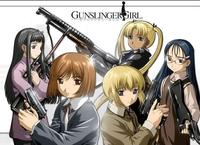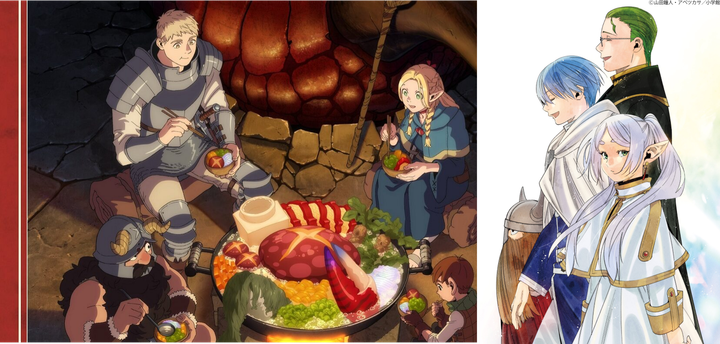Gunslinger Girl Anime Review

Gunslinger Girl
Gunslinger Girl: Il Teatrino
Written by Yu Aida 相田 裕 Aida Yutaka
Published by Funimation

Gunslinger Girl
ガンスリンガー·ガール Gansuringā Gāru
This review covers the two anime series Gunslinger Girl and Gunslinger Girl: Il Teatrino. Each is a 13-episode adaption of the manga by Yu Aida. Each season covers only part of the manga, which as of the time of this review has 11 volumes published in Japan. These seasons cover roughly the first six volumes, but not exhaustively.
The first season is simply beautifully done. Motions are fluid, proportions are maintained in perspective, and detail is high. However, the first season is rather unfocused, not following any particular story arc with any fidelity. Il Teatrino on the other hand, was personally supervised by Aida, and consequently is very tightly plotted, but suffers from lackluster animation that is often crudely drawn. I enjoyed both seasons, but these differing strengths ought to be borne in mind by any potential viewers.
Gunslinger Girl is a story both about the fractious nature of Italian politics and the consequences borne by the players in the Great Game of politics by other means. The focus is upon the fratello of the Social Welfare Agency. The Social Welfare Agency is a front for a mysterious organization known only as Section 2. They do in fact do some good, because the same technology that allows them to create cyborg assassins can also be used to cure the lame and allow the blind to see. However, that is not the Agency's primary purpose. Their job is to eliminate the enemies of the Italian state.
Each fratello is a team composed of a handler and a cyborg. The handlers are usually recruited from the military or from other intelligence agencies, whereas the cyborgs are created from orphans rescued from hospitals. I say rescued, when perhaps kidnapped would be more accurate. Only orphans are used, and most often the girls selected would otherwise die if not for the intervention of the Agency. Only girls are used, because for some reason the process works better on girls, the younger the better.
This sounds horrible, and it is, but there is at least a patina of actual concern layered over the Machiavellian purpose of Section 2. In addition to being crippled, the girls have usually been psychologically traumatized. The psychoactive drugs used to control the girls and unite them with their mechanical bodies have the blessed side effect of erasing their memories: they cannot remember their families or their families terrible ends. The girls cannot remember their past lives, but every night they silently weep in their sleep, mourning their lost humanity.
Accordingly, their handlers must fill the roles of father, brother, and even lover. This is not to say that we have mechanical lolitas. The drugs were meant to produce unquestioning obedience, but instead prompt a fierce, and even dangerously unstable attachment born of the girls' need to be loved. This provides the central drama of the series, because even the hardened men who are recruited for Section 2 cannot easily reconcile themselves to what they are really doing.
This is compounded by the the tradeoff produced by the conditioning: more conditioning produces a more pliable girl, but makes her duller and shortens her life. Those handlers who choose to minimize the conditioning find they need to buy their cyborgs teddy bears and take them on outings to maximize their kill count. For dramatic purposes, most of the handlers have psychological hangups involving innocent young girls. You would think a mysterious government agency could vet their employees better, but that is not really the point here.
The central drama is provided by the essential immorality of using brainwashed girls as assassins, but the series would not be near so interesting if it weren't set in an Italy of the near future. I am not an expert on Italian history or politics, but what I do know very much tracks with what you see in Gunslinger Girl. Italian politics in some ways still operates in the Renaissance mode of constant intrigue and upheaval. Add on top of this the recent unification of Italy into a nation by force, the influence of the Mafia in the south, and the critical role Italy played in the Cold War and you have many well-armed and well-financed factions prepared to fight for power. The separatist Padania organization featured in the series actually has real world counterparts in Italy. It is of course unwise to get historical and political information exclusively from entertainment, but as long as one keeps the inherent limitations of the medium in mind this is a good way to spur interest in a subject.
I would classify Gunslinger Girl as gun porn, in the same sense Steve Sailer refers to movies like Brideshead Revisited and Atonement as period porn. Each gun is lovingly drawn, a precise representation of an actual firearm. Since gun ownership is nearly nonexistent in Japan, there is a gun-loving subculture there that finds fulfillment in anime like this and in buying very expensive Airsoft replicas of real guns. Each gun used by one of the girls is readily identifiable: Henrietta's FN Herstal P90, Triela's Winchester 1897 Trench Gun, or Rico's CZ-75 pistol. This, and the lolita aspect probably explain the series' popularity, but there is an underlying historical acumen that makes this anime worth seeing.



Comments ()